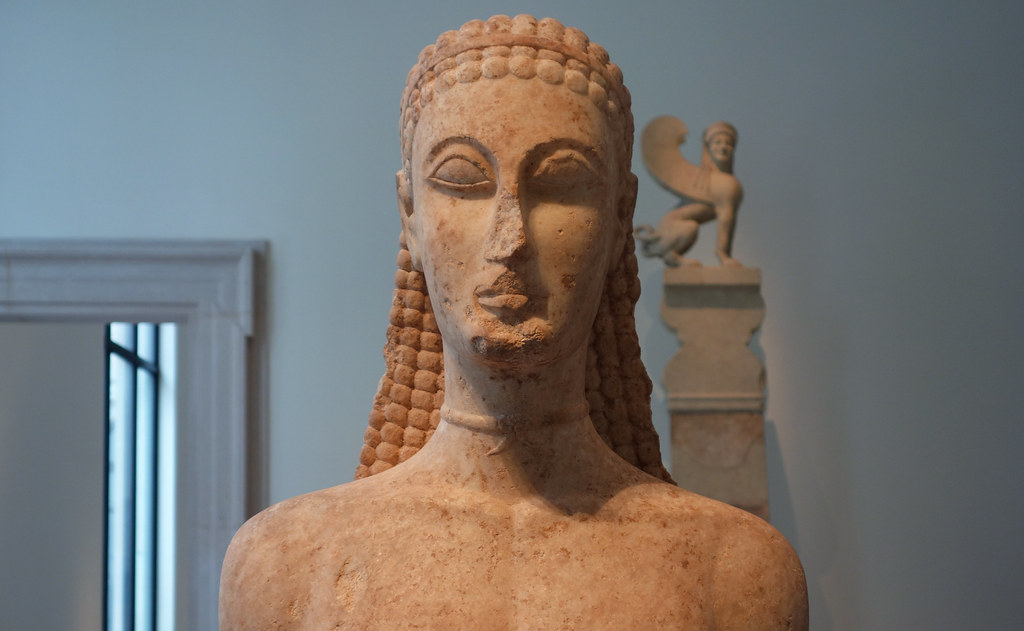Sculpture At The Met - The Metropolitan Museum of Art has an extensive collection of sculptures from various regions and periods in history. From ancient Greek and Roman sculptures to more contemporary pieces, the Met's collection offers a glimpse into the evolution of sculpture as an art form.
New York Kouros, bust
Ancient Greece

The New York Kouros is a marble statue of a young man dating back to the early 6th century BC. It is an archaic Greek sculpture that reflects the influence of Egyptian art on Greek sculpture. The statue is one of the earliest examples of the kouros style, which is characterized by the representation of a standing male figure with one foot slightly advanced and the other foot firmly planted on the ground. The New York Kouros is also an excellent example of the Ancient Greek ideal of the perfect male body, with its muscularity and idealized proportions.
Roman sculpture
Rome

The Met's collection of Roman sculptures is one of the largest and most comprehensive in the world. The collection includes works from throughout the Roman Empire, including Italy, Greece, Egypt, and the provinces of the Roman Empire. Roman sculpture was heavily influenced by Greek art, but also had distinctive characteristics of its own. Roman sculpture was often used to commemorate important individuals, such as emperors, and to celebrate military victories.
Casting Sculpture Definition
African Sculpture

Casting sculpture is a process used to make three-dimensional artworks by pouring molten metal, plaster, or other materials into a mold. It is a time-consuming process that requires great skill and attention to detail. African sculpture is known for its intricate designs and attention to detail, and many African sculptures have been created using the casting sculpture method. The Met has an excellent collection of African sculptures, including some that were created using the casting sculpture method.
Marble bust of Herodotos
Imperial Rome

The marble bust of Herodotos is an excellent example of a Roman bust from the Imperial period. Herodotos was a Greek historian who lived in the 5th century BC, and his writings were highly regarded by the Romans. The bust shows Herodotos with a full beard and a serious expression, reflecting the ancient Greek ideal of the philosopher. The Met's collection of Roman busts is one of the largest in the world and includes works from throughout the Roman Empire.
Friday Afternoon
Contemporary Art

The Met's collection of contemporary art includes works from artists around the world. The collection is varied and includes sculptures made from a variety of materials, including metal, glass, and plastic. The Friday Afternoon sculpture is a contemporary piece created by an unknown artist. The sculpture is playful and whimsical, featuring a colorful figure sitting on a bench with a book in hand. The Met's collection of contemporary art highlights the diversity and vibrancy of the art world today.
Tips and Ideas
The Metropolitan Museum of Art is a wonderful place to explore the history and evolution of sculpture as an art form. Here are some tips and ideas to help you make the most of your visit:
- Take a guided tour: The Met offers a variety of tours that focus specifically on sculpture and can provide you with deeper insights and context about the works in the collection.
- Explore the rooftop garden: The rooftop garden at the Met is home to a rotating series of contemporary sculptures and offers stunning views of Central Park and the Manhattan skyline.
- Don't miss the ancient Egyptian collection: While the Met's collection of sculptures is extensive, the ancient Egyptian collection is particularly fascinating and includes many iconic works such as the Temple of Dendur.
How To Get There
The Metropolitan Museum of Art is located in Manhattan at 1000 5th Ave. The easiest way to get there is by subway. Take the 4, 5, or 6 train to 86th St. and walk two blocks east to the museum. You can also take the M1, M2, M3, or M4 bus to 82nd St. and 5th Ave. if you prefer. The museum is open seven days a week, and admission is by donation, so you can pay what you can afford.
Overall, the Met's collection of sculptures is a remarkable and valuable resource for anyone interested in the history and evolution of sculpture as an art form. It is well worth a visit for anyone who loves art and wants to learn more about the creative vision and skill of artists from around the world and throughout history.
Read more articles about Sculpture At The Met